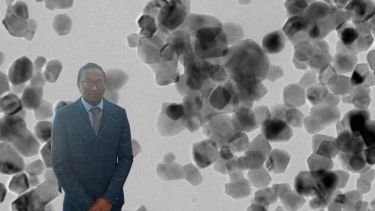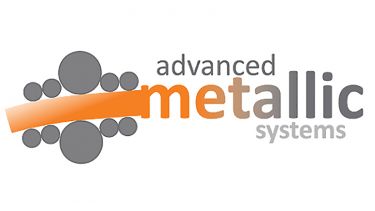A project led by Anesu Nyabadza, PhD Researcher in the Advanced Metallic Systems Centre for Doctoral Training Programme at Dublin City University, will develop a novel approach to nanoparticle fabrication to assist in the manufacturing of magnesium nanoparticles for commercial purposes. Magnesium nanoparticles are used in printed electronic and drug delivery due to their high conductivity and biocompatibility.
This research focusses specifically on pulsed laser ablation in liquid [PLAL], in a bid to reduce the costs associated with potential commercialisation, which was selected due to the precise control of the nanoparticle size possible through the fabrication method.
The project works collaboratively with Oriel Marine Extracts and Sea Salt. Prof. Dermot Brabazon, AMS CDT ROI Director, Dublin City University, and Dr Mercedes Vázquez, Assistant Professor in Analytical Chemistry, Dublin City University, are also involved in the research development.
Why is this Important?
Currently, magnesium nanoparticles [Mg NPs] are rarely manufactured due to the high cost associated with the conventional fabrication methods, and the limited number of nanoparticle manufacturers in the sector. Conventional fabrication methods are also limited in nanoparticle size control, which has resulted in little research development in this area.
The focus of this research is Pulsed Laser Ablation in Liquid [PLAL] to demonstrate the viability of PLAL in the synthesis of Mg NPs, in a bid to increase knowledge in this sector while exploring the feasibility of commercialising manufacturing of Mg NPs. Current methods, notably wet chemical synthesis, have limited efficiency due to documented difficulties in large-scale production, high reaction temperature, and the use of surfactants.
In contrast to the currently used wet chemical synthesis method, PLAL produces clean NPs, meaning that contamination and the use of hazardous chemicals are avoided, resulting in both environmental and health benefits. The potential to manufacture at a lower-cost through the PLAL method also makes commercialisation potentially viable. Commercialisation of these nanoparticles is of high importance for both the electronic and medical industries, due to their use in multiple applications. If manufacturing costs can be significantly reduced through the efficiency of the PLAL method, this would result in lasting economic benefit for multiple sectors.
Underpinning Research
Pulsed Laser Ablation in Liquid [PLAL] is a technique that has been utilised for over 20 years. The method has seen success in synthesising multiple classifications of nanoparticles, such as Ag, Au, Cu, C, Si, for example.
This research builds upon existing findings, by utilising the method to investigate the synthesis of magnesium nanoparticles which are rarely fabricated. It has been found that each material requires different processing parameters during the PLAL method, however, comparisons can be made based on the properties of material tested, whilst also gathering novel data relating to the process.
Current Findings
Nanoparticle size and concentration detect their properties, and by extension, their applications. This project aims to demonstrate that a nanoparticle fabrication method such as PLAL, which enables precise control of nanoparticle size and concentration, is promising for the manufacturing of commercial magnesium nanoparticles [Mg NPs].
During the synthesis of Mg NPs via the PLAL method, Mg powder [about 2g] is eroded under IPA liquid [Isopropyl Alcohol] using an Nd:YAG, 1064 nm laser. The variation of the laser parameters directly influences the nanoparticle size and concentration.
For the purpose of this project, a Design of Experiments [DOE] was created to study the effect of the laser processing parameters on the nanoparticle size and concentration. These parameters include: laser scan speed, fluence, pulse width, repetition rate, and ablation time. The liquid [IPA, ethanol, and DI water] in which PLAL is conducted, were also observed to influence the outputs.
Current findings determined from this method resulted in the following:
- DI water-synthesised Mg NPs tend to be larger than IPA-synthesised Mg NPs.
- 2 min ablation time produces bimodal Mg NP size distributions; 25 min ablation time produces positively skewed/normal distributions.
- Mg NPs reduced the resistivity of glass from 102 to 92 Ω/square which demonstrated their potential application in electronics.
What’s Next?
Following the previous testing, the fabricated Mg NPs are in the process of being inkjet printed onto paper, to demonstrate proof-of-concept for paper electronic applications.
These printed tracks will be subjected to electrical conductivity tests, as well as dimensional accuracy tests. Following the success of this testing, the Mg NPs can be used in the future for coating polymers [e.g., polylactic acid - PLA] for biomedical implants.
Subject to successful outcome, there is the potential for future collaborative projects working with the School of Biotechnology, Dublin City University, to determine the effectiveness of these synthesised Mg NPs for drug delivery applications.
This research has the potential for long-term last impact in multiple sectors following its successful implementation. Positive benefits have been identified in the health sector, via the drug delivery application and the production of ‘clean’ nanoparticles by removing the need for hazardous chemicals in the manufacturing process. Green nanoparticles have also been found to lessen the side-effects of medications in drug delivery.
Furthermore, low-powdered lasers have been utilised throughout this project, resulting in a significantly reduced energy output and cost comparative to currently used wet chemical methods. Due to this, the adoption of PLAL in manufacturing for both drug delivery applications and printed electronics could reduce the environmental impact associated with production significantly.
Anesu Nyabadza has published significant amounts of literature in this area [1–6], in a bid to increase awareness of the benefits of fabricating Mg NPs via PLAL and accelerate the steps to its commercialisation through knowledge exchange.
[1] A. Nyabadza, M. Vázquez, D. Brabazon, Magnesium nanoparticle synthesis from powders via LASIS - Effects of liquid medium, laser pulse width and ageing on nanoparticle size, concentration, stability and electrical properties, Colloids Surfaces A Physicochem. Eng. Asp. (2022) 129651. https://doi.org/10.1016/J.COLSURFA.2022.129651.
[2] A. Nyabadza, M. Vázquez, S. Coyle, B. Fitzpatrick, D. Brabazon, Magnesium Nanoparticle Synthesis from Powders via Pulsed Laser Ablation in Liquid for Nanocolloid Production, Appl. Sci. 2021, Vol. 11, Page 10974. 11 (2021) 10974. https://doi.org/10.3390/APP112210974.
[3] A. Nyabadza, M. Vázquez, S. Coyle, B. Fitzpatrick, D. Brabazon, Review of Materials and Fabrication Methods for Flexible Nano and Micro-Scale Physical Property Sensors, Appl. Sci. 11 (2021) 1–36. https://doi.org/10.3390/app11188563.
[4] A. Nyabadza, M. Vázquez, B. Fitzpatrick, D. Brabazon, Effect of liquid medium and laser processing parameters on the fabrication of carbon nanoparticles via pulsed laser ablation in liquid towards paper electronics, Colloids Surfaces A Physicochem. Eng. Asp. 636 (2022) 128151. https://doi.org/10.1016/J.COLSURFA.2021.128151.
[5] A. Nyabadza, M. Vázquez, D. Brabazon, Modelling of Pulsed Laser Ablation in Liquid via Monte Carlo techniques: The effect of laser parameters and liquid medium on the electron cloud, Solid State Sci. (2022) 107003. https://doi.org/10.1016/J.SOLIDSTATESCIENCES.2022.107003.
[6] A. Nyabadza, J. Kane, S. Sreenilayam, M. Vázquez, D. Brabazon, S. Sreenilayam, D. Brabazon, Multi-Material Production of 4D Shape Memory Polymer Composites, in: Mater. Sci. Mater. Eng. Elsevier, 2021, Elsevier, 2021: pp. 879–894. https://doi.org/10.1016/B978-0-12-819724-0.00057-4.
Equipment and Facilities
This project utilised multiple characterisation techniques through equipment at various universities.
- TEM/EELS, Trinity College, Dublin
- SEM/EDX, Dublin City University, and University College Dublin
- XPS, Dublin City University, and University College Dublin
- FTIR, Dublin City University
- UV-Visible Spectroscopy, Dublin City University
- 4-Point Probe, Dublin City University
All laser ablation experiments were conducted via facilities at Dublin City University.



